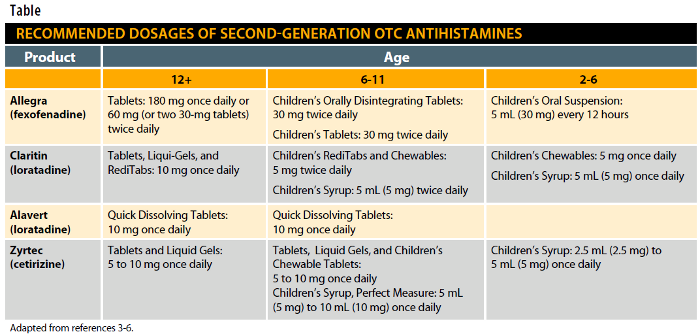Article
Perspectives on Second-Generation OTC Antihistamines
INTRODUCTION
With allergy season upon us, people will be seeking an OTC product for allergy symptom relief, and pharmacists will be making recommendations based on individual patients’ needs (eg, fast working, nonsedating, and long lasting). Allergies often manifest after several seasonal exposures to the same set of pollens or potential allergens.
1
Therefore, the onset of allergy symptoms commonly begins at 4 to 5 years of age, and allergic rhinitis (AR) is considered the most common chronic childhood disease.
1,2
Many sufferers can appropriately treat AR with an OTC medication, and 3 second-generation antihistamines are available.
2-6
Because pharmacists are often asked to make OTC recommendations for AR relief, they must be aware of the prevalence, etiologies, and manifestations of AR, and approaches to its treatment.
PERENNIAL VERSUS SEASONAL ALLERGIC RHINITIS
Perennial AR occurs year-round regardless of season and is triggered by aeroallergens such as dog/cat dander, dust mite residue, cosmetics, cockroaches, and mold.
7
By definition, seasonal AR, also known as hay fever, is associated with specific seasons of the year.
2,7
Tree pollen, for example, typically peaks in spring (generally from March to June). However, timing varies based on geographic region.
7
AR affects up to 30% of adults and 40% of children in the United States annually; most people develop AR before the age of 20.
7
AR results in over 20 million doctor appointments,
8
125 million days of reduced productivity, over 3 million missed work days,
9
and 2 million missed school days every year.
7
AR is characterized by 1 or more of the following symptoms: nasal congestion, rhinorrhea, sneezing, and itching. Ophthalmic symptoms include red, itching, and tearing eyes. AR can be associated with comorbidities, such as asthma, sinusitis, otitis media, and sleep apnea.
7
Quality-of-life issues associated with AR include sleep disturbance, irritability, depression, productivity loss, slowed psychomotor response times, impaired learning and decision making, and fatigue.
2
It is important to note that impaired motor activity and fatigue can also be associated with antihistamine use, and this should be considered when selecting the appropriate AR medication.
In patients previously sensitized to specific aeroallergens, subsequent exposure induces an immunoglobulin E—mediated biochemical cascade resulting in mast cell/basophil degranulation and release of inflammatory mediators.
10
While an individual’s response to allergens varies, OTC therapies can offer an effective initial approach to treatment, should allergen avoidance be difficult or impractical.
PHARMACOLOGY OF ANTIHISTAMINES
Antihistamines used to treat AR are competitive antagonists for histamine-1 (H1) receptors found on target cell surfaces in the nose, lung, conjunctiva, and skin. They also change the 3-dimensional configuration of the H1 receptor, which diminishes its affinity for histamine, resulting in the down-regulation of histamine-dependent symptoms.
11
Both first- and second-generation antihistamines alleviate AR symptoms or other upper respiratory allergies. First-generation OTC antihistamines include diphenhydramine (eg, Benadryl), chlorpheniramine (eg, Chlor-Trimeton), and clemastine (eg, Tavist); second-generation products include fexofenadine (eg, Allegra), loratadine (eg, Claritin and Alavert), and cetirizine (eg, Zyrtec).
2
Because some second-generation antihistamines are less likely to cross the blood-brain barrier than first-generation antihistamines, they are associated with fewer nervous system effects, such as drowsiness.
11
For this reason, second-generation antihistamines are often referred to as “nonsedating” antihistamines.
2
However, this varies even among second-generation options. For example, the labeling information for cetirizine indicates that “drowsiness may occur” and to “be careful when driving a motor vehicle or operating machinery.”
6
Fexofenadine, however, has no drowsiness or driving warnings.
3
SECOND-GENERATION OTC ANTIHISTAMINES
Second-generation OTC antihistamines are available in a wide variety of dosages for adults. They are appropriate for use in the pediatric population, and 3 products, Allegra, Claritin, and Zyrtec, are FDA-approved as liquid formulations for use in children 2 years and older.
3,4,6
Pregnant or breastfeeding women should seek their physician’s advice prior to taking any antihistamines.
2
Dosage information for OTC second-generation antihistamines is listed in the Table.
Efficacy in AR Symptom Relief
Results from clinical studies indicate that fexofenadine (Allegra) and cetirizine (Zyrtec) generally have a quicker onset of action in AR than loratadine (Claritin).
12
A 2-week, multicenter, double-blind, randomized study compared the efficacy of fexofenadine 180 mg and cetirizine 10 mg in patients with moderate-to-severe AR (n = 495).
13
Those given fexofenadine demonstrated statistically equivalent improvement in allergy symptoms as those given cetirizine. Similar results were observed in another study of fexofenadine and cetirizine with 821 patients.
14
Side Effects
At higher-than-recommended doses, sedation can occur with loratadine.
4
Some patients taking cetirizine may experience sedation even at recommended doses.
6
Fexofenadine, even at higher-than-recommended doses, has not been associated with sedation.
7,15
Compared with patients given cetirizine, those given fexofenadine had significantly greater improvements from baseline in visual analog scale (VAS) drowsiness scores at all 3 time points evaluated (P <.05 for all).
13
Also, there was a trend toward greater improvements from baseline in overall motivation VAS scores with fexofenadine compared with cetirizine (P = .0504).
In another study, drowsiness occurred in 3% each of the fexofenadine and placebo groups and in 6% of the cetirizine group.
14
Also, the combined incidence of fatigue or drowsiness was greater in the cetirizine group (9%) than in the fexofenadine or placebo groups (4% each); the difference was significant for cetirizine versus fexofenadine (P = .018).
The effects of fexofenadine, diphenhydramine, alcohol, and placebo were assessed in a randomized, double-blind, 4-treatment, 4-period crossover trial of 40 licensed drivers with seasonal AR aged 25 to 44 years.
16
Fexofenadine 60 mg, diphenhydramine 50 mg, alcohol (blood concentration approximately 0.1%), or placebo were administered at weekly intervals before participants drove 1 hour in the Iowa Driving Simulator. Participants demonstrated similar performance with placebo and fexofenadine. Driving performance was the worst with diphenhydramine.
Label Warnings
The cetirizine label includes warnings that drowsiness may occur, alcohol may increase drowsiness, and patients should be careful when driving or operating machinery.
6
Loratadine is nonsedating at recommended doses, but at higher-than-recommended doses, sedation can occur.
4
The fexofenadine label does not include a drowsiness warning.
3
Other Considerations
Medication and food warnings for fexofenadine include avoiding fruit juice (taking it with water is recommended) and aluminum- or magnesium-containing antacids.
3
Patients taking cetirizine should avoid alcohol, sedatives, and tranquilizers, as they may increase drowsiness.
6
Pregnant or breastfeeding women should consult a clinician prior to taking any of the 3 products, and all are contraindicated in renal dysfunction (physician consultation recommended). Loratadine and cetirizine are also contraindicated in patients with hepatic disease; however, fexofenadine is not.
3,4,6
CONSIDERATIONS FOR THE PHARMACIST
AR is a very common condition and its symptoms can cause significant disruptions in daily activities. There are many effective treatments available for AR; however, patients may be confused by product labeling. Pharmacists can inform and educate patients about available OTC products, point out differences in labeling, and help patients determine which medication is best for their needs. Because Allegra provides powerful efficacy in AR without the risk of sedation, it is a good first choice when making recommendations in this class.

REFERENCES
- Kulig M, Klettke U, Wahn V, Forster J, Bauer CP, Wahn U. Development of seasonal allergic rhinitis during the first 7 years of life. J Allergy Clin Immunol. 2000;106(5):832-839.
- Pray WS, Pray GE. Allergic rhinitis: nonprescription treatment options. US Pharm. 2011;36:14-19.
- Allegra website. www.allegra.com. Accessed January 29, 2012.
- Claritin website. www.claritin.com. Accessed January 29, 2012.
- Alavert website. www.alavert.com. Accessed January 29, 2012.
- Zyrtec website. www.zyrtec.com. Accessed January 29, 2012.
- Wallace DV, Dykewicz MS, Bernstein DI, et al; Joint Task Force on Practice Parameters; American Academy of Allergy, Asthma & Immunology; American College of Allergy, Asthma and Immunology; Joint Council of Allergy, Asthma and Immunology. The diagnosis and management of rhinitis: an updated practice parameter. J Allergy Clin Immunol. 2008;122(2)(suppl):S1-S84.
- Storms W, Meltzer EO, Nathan RA, Selner JC. The economic impact of allergic rhinitis. J Allergy Clin Immunol. 1997;99:S820-S824.
- Crystal-Peters J, Crown WH, Goetzel RZ, Schutt DC. The cost of productivity losses associated with allergic rhinitis. Am J Manag Care. 2000;6(3):373-378.
- Austen KF. Allergies, anaphylaxis, and systemic mastocytosis: introduction. In: Longo D, Fauci A, Kasper D, Hauser S, Jameson J, Loscalzo J, eds. Harrison’s Principles of Internal Medicine, 18e (online).
- Krouse JH. Allergic rhinitis--current pharmacotherapy. Otolaryngol Clin North Am. 2008;41:347-358.
- Greisner WA 3rd. Onset of action for the relief of allergic rhinitis symptoms with second-generation antihistamines. Allergy Asthma Proc. 2004;25(2):81-83.
- Hampel F, Ratner P, Mansfield L, Meeves S, Liao Y, Georges G. Fexofenadine hydrochloride, 180 mg, exhibits equivalent efficacy to cetirizine, 10 mg, with less drowsiness in patients with moderate-to-severe seasonal allergic rhinitis. Ann Allergy Asthma Immunol. 2003;91:354-361.
- Howarth PH, Stern MA, Roi L, Reynolds R, Bousquet J. Double-blind, placebo-controlled study comparing the efficacy and safety of fexofenadine hydrochloride (120 and 180 mg once daily) and cetirizine in seasonal allergic rhinitis. J Allergy Clin Immunol. 1999;104:927-933.
- Vermeeren A, O’Hanlon JF. Fexofenadine’s effects, alone and with alcohol, on actual driving and psychomotor performance. J Allergy Clin Immunol. 1998;101(3):306-311.
- Weiler JM, Bloomfield JR, Woodworth GG, et al. Effects of fexofenadine, diphenhydramine, and alcohol on driving performance: a randomized, placebo-controlled trial in the Iowa driving simulator. Ann Intern Med. 2000;132:354-363.





